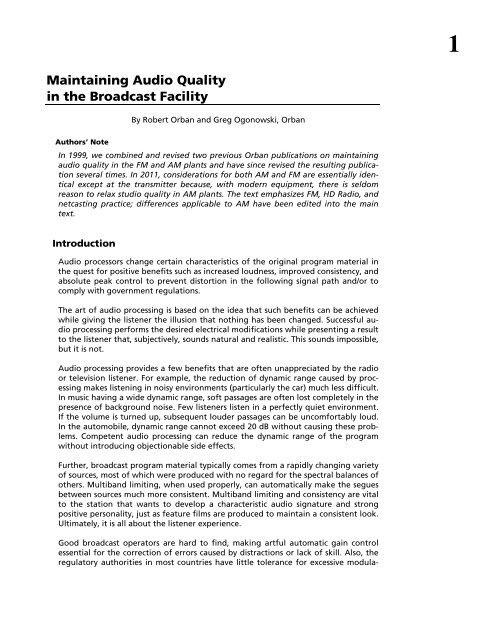Maintaining Audio Quality in the Broadcast Facility 2011 - Orban
Maintaining Audio Quality in the Broadcast Facility 2011 - Orban
Maintaining Audio Quality in the Broadcast Facility 2011 - Orban
Create successful ePaper yourself
Turn your PDF publications into a flip-book with our unique Google optimized e-Paper software.
<strong>Ma<strong>in</strong>ta<strong>in</strong><strong>in</strong>g</strong> <strong>Audio</strong> <strong>Quality</strong><br />
<strong>in</strong> <strong>the</strong> <strong>Broadcast</strong> <strong>Facility</strong><br />
By Robert <strong>Orban</strong> and Greg Ogonowski, <strong>Orban</strong><br />
Authors’ Note<br />
In 1999, we comb<strong>in</strong>ed and revised two previous <strong>Orban</strong> publications on ma<strong>in</strong>ta<strong>in</strong><strong>in</strong>g<br />
audio quality <strong>in</strong> <strong>the</strong> FM and AM plants and have s<strong>in</strong>ce revised <strong>the</strong> result<strong>in</strong>g publication<br />
several times. In <strong>2011</strong>, considerations for both AM and FM are essentially identical<br />
except at <strong>the</strong> transmitter because, with modern equipment, <strong>the</strong>re is seldom<br />
reason to relax studio quality <strong>in</strong> AM plants. The text emphasizes FM, HD Radio, and<br />
netcast<strong>in</strong>g practice; differences applicable to AM have been edited <strong>in</strong>to <strong>the</strong> ma<strong>in</strong><br />
text.<br />
Introduction<br />
<strong>Audio</strong> processors change certa<strong>in</strong> characteristics of <strong>the</strong> orig<strong>in</strong>al program material <strong>in</strong><br />
<strong>the</strong> quest for positive benefits such as <strong>in</strong>creased loudness, improved consistency, and<br />
absolute peak control to prevent distortion <strong>in</strong> <strong>the</strong> follow<strong>in</strong>g signal path and/or to<br />
comply with government regulations.<br />
The art of audio process<strong>in</strong>g is based on <strong>the</strong> idea that such benefits can be achieved<br />
while giv<strong>in</strong>g <strong>the</strong> listener <strong>the</strong> illusion that noth<strong>in</strong>g has been changed. Successful audio<br />
process<strong>in</strong>g performs <strong>the</strong> desired electrical modifications while present<strong>in</strong>g a result<br />
to <strong>the</strong> listener that, subjectively, sounds natural and realistic. This sounds impossible,<br />
but it is not.<br />
<strong>Audio</strong> process<strong>in</strong>g provides a few benefits that are often unappreciated by <strong>the</strong> radio<br />
or television listener. For example, <strong>the</strong> reduction of dynamic range caused by process<strong>in</strong>g<br />
makes listen<strong>in</strong>g <strong>in</strong> noisy environments (particularly <strong>the</strong> car) much less difficult.<br />
In music hav<strong>in</strong>g a wide dynamic range, soft passages are often lost completely <strong>in</strong> <strong>the</strong><br />
presence of background noise. Few listeners listen <strong>in</strong> a perfectly quiet environment.<br />
If <strong>the</strong> volume is turned up, subsequent louder passages can be uncomfortably loud.<br />
In <strong>the</strong> automobile, dynamic range cannot exceed 20 dB without caus<strong>in</strong>g <strong>the</strong>se problems.<br />
Competent audio process<strong>in</strong>g can reduce <strong>the</strong> dynamic range of <strong>the</strong> program<br />
without <strong>in</strong>troduc<strong>in</strong>g objectionable side effects.<br />
Fur<strong>the</strong>r, broadcast program material typically comes from a rapidly chang<strong>in</strong>g variety<br />
of sources, most of which were produced with no regard for <strong>the</strong> spectral balances of<br />
o<strong>the</strong>rs. Multiband limit<strong>in</strong>g, when used properly, can automatically make <strong>the</strong> segues<br />
between sources much more consistent. Multiband limit<strong>in</strong>g and consistency are vital<br />
to <strong>the</strong> station that wants to develop a characteristic audio signature and strong<br />
positive personality, just as feature films are produced to ma<strong>in</strong>ta<strong>in</strong> a consistent look.<br />
Ultimately, it is all about <strong>the</strong> listener experience.<br />
Good broadcast operators are hard to f<strong>in</strong>d, mak<strong>in</strong>g artful automatic ga<strong>in</strong> control<br />
essential for <strong>the</strong> correction of errors caused by distractions or lack of skill. Also, <strong>the</strong><br />
regulatory authorities <strong>in</strong> most countries have little tolerance for excessive modula-<br />
1



![[PDF] Using the ITU BS.1770-2 and CBS Loudness Meters ... - Orban](https://img.yumpu.com/50629372/1/190x245/pdf-using-the-itu-bs1770-2-and-cbs-loudness-meters-orban.jpg?quality=85)






![[PDF] Optimod-FM Feature Comparison - Orban](https://img.yumpu.com/41741615/1/190x245/pdf-optimod-fm-feature-comparison-orban.jpg?quality=85)






